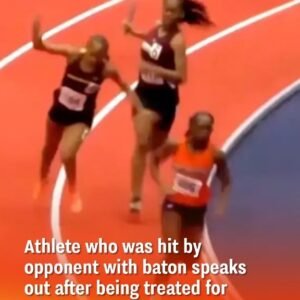I. Introduction
A shocking incident during the Virginia High School League (VHSL) Class 3 State Indoor Championships has ignited widespread debate over sportsmanship, athlete safety, and fair play.
During the 4×200 meter relay final, Brookville High School junior Kaelen Tucker was struck in the head with a baton by an opposing runner, Alaila Everett from I.C. Norcom High School. The impact resulted in severe injury, with concussion symptoms and a potential skull fracture.
Footage of the race shows the moment of impact, prompting VHSL officials to disqualify the I.C. Norcom team for “contact interference.” However, the incident has sparked heated discussions regarding whether the contact was intentional or an unfortunate accident.
This report examines:
✅ Tucker’s firsthand account of what happened.
✅ Reactions from coaches, parents, and officials.
✅ The legal and disciplinary implications of the incident.
✅ The broader debate over safety and accountability in high school sports.
II. Background and Competitive Setting
A. The Track & Field Championships: A High-Stakes Event
The VHSL Class 3 State Indoor Championships is a premier event where top high school athletes compete for state titles and recognition.
✅ Kaelen Tucker, a standout sprinter from Brookville High School, had already made headlines earlier in the meet by setting a state record in the 55-meter dash.
✅ Her next goal: helping her team win the 4×200 meter relay final.
✅ However, the relay race took a dramatic and controversial turn, ending in injury, disqualification, and heated debate.
B. Track & Field Safety Rules: The Role of VHSL Officials
High school relay races follow strict rules to ensure fair competition and athlete safety:
🚨 Baton exchanges must occur in designated zones.
🚨 Contact between runners must be incidental, not intentional.
🚨 Unsportsmanlike conduct can lead to disqualification.
VHSL officials reviewed the race footage and ruled that the I.C. Norcom team was guilty of “contact interference.” However, this ruling has done little to settle the controversy, with some arguing the action was deliberate and dangerous.
C. The Importance of Sportsmanship in High School Athletics
High school sports emphasize:
✅ Fair play
✅ Respect for opponents
✅ Safe competition
However, Tucker’s account suggests that this incident was not simply a racing accident but rather a deliberate or negligent act by her opponent.
III. The Incident: What Happened?
A. The Race Unfolds
🔹 During the 4×200 meter relay final, Tucker and Everett were battling for position on the track’s back curve.
🔹 Tucker attempted to pass Everett, who was running for I.C. Norcom High School.
🔹 As Tucker moved forward, she was suddenly struck in the head with a baton.
B. Tucker’s Firsthand Account
Tucker recalls:
“When I finally pushed through to get in front of her, that’s when she hit me in the head with the baton.”
🔹 The impact left Tucker disoriented and in pain.
🔹 She ran off the track, clutching her head, before collapsing from the injury.
🔹 Witnesses described the collective gasp from the crowd as the baton struck her.
🚑 Medical personnel immediately attended to Tucker, assessing symptoms consistent with a concussion and potential skull fracture.
C. Opposing Athlete’s Response: Intentional or Accidental?
🔹 Alaila Everett denied hitting Tucker on purpose, telling WAVYTV10:
“I would never hit somebody on purpose.”
🔹 Everett claims:
✅ She misjudged her distance.
✅ She lost her balance after the baton made contact.
✅ The impact was accidental.
However, many observers remain skeptical, arguing that:
🚨 The video shows a clear and forceful baton strike.
🚨 The injury was too severe to be a simple accident.
🚨 Everett has not yet directly apologized to Tucker.
IV. The Fallout: Injury, Investigation, and VHSL Decision
A. Immediate Aftermath: Medical Concerns
🚑 Tucker’s injuries were serious:
❌ Concussion symptoms
❌ Possible skull fracture
❌ Emotional distress
Her mother, Tamarrow Tucker, described the terrifying moment:
“When I saw her go down, all I could do was run out of the bleachers. I just knew I had to get to her.”
B. VHSL Disqualifies I.C. Norcom for “Contact Interference”
📢 VHSL reviewed race footage and ruled:
✅ I.C. Norcom was guilty of “contact interference”.
✅ The team was disqualified from the event.
✅ However, no individual penalties were issued.
🔹 Tucker’s family believes the ruling is not enough and is calling for stronger disciplinary action.
C. Potential Legal Implications
Some experts argue that:
🚨 If the baton strike was intentional, it could be considered assault.
🚨 Criminal charges could be possible if recklessness is proven.
This raises important questions about accountability for dangerous conduct in high school sports.
V. The Debate Over Athlete Safety and Accountability
A. Should There Be Stricter Penalties for Dangerous Conduct?
🚨 Some argue that VHSL’s disqualification was not enough and that:
✅ Stronger penalties should be enforced for serious incidents.
✅ Athletes should be held accountable for reckless or violent actions.
✅ High school sports need better oversight to prevent injuries.
B. Calls for Greater Sportsmanship and Respect
🎖️ Many believe that this incident highlights a lack of sportsmanship, arguing that:
✅ Winning should never come at the cost of harming an opponent.
✅ Fair competition is the foundation of high school sports.
✅ Better training and coaching are needed to emphasize respect on the track.
🔹 Tucker herself has spoken out, demanding an apology and accountability from Everett.
VI. Conclusion: What Comes Next?
The baton strike controversy has:
🔥 Sparked a major debate on athlete safety.
🔥 Put VHSL’s rules and enforcement under scrutiny.
🔥 Raised serious questions about accountability in high school sports.
📢 Moving forward, officials, coaches, and athletes must:
✅ Ensure fair and safe competition.
✅ Hold athletes accountable for unsportsmanlike behavior.
✅ Strengthen rules to prevent future incidents.
The incident involving Kaelen Tucker is more than just a track & field controversy—it’s a pivotal moment for the future of high school sports.
📣 What do you think? Should VHSL impose stricter penalties for dangerous conduct in competitions? Let’s discuss.
